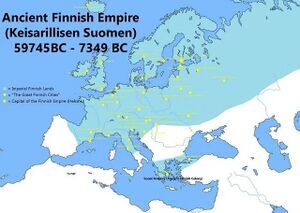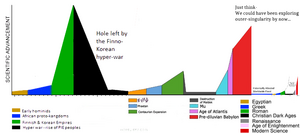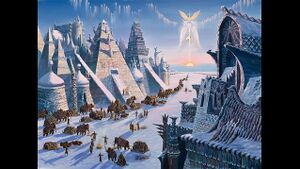Proto-Finnic Holy Roman Khaganate
Keisarillisen Suomen Pyhä Roomalainen Kaganaatti / Soomen pühä romalainen ruhtinaskunta Proto-Finnic Holy Roman Khaganate Ancient Finnish Empire | |||
|---|---|---|---|
| |||
| Motto: Perkelen Kaudan, Maailmad Käldämä(Perkeleen Kautta, Maailmat Kahlitsemme) | |||
 Map of Proto-Finland at its estimated greatest extent (around 11000 B.C.) | |||
| Capital | Helsinki | ||
| Largest city | Old Ulan-Bator | ||
| Official language(s) | Proto-Finnic | ||
| Government | Totalitarian Khaganate with a spice of mammoths | ||
| ‑ The Great Khagan, Grandson of Tengri and Son of Ukko | Holy Emperor | ||
| Currency | Raha (squirrel skin) | ||
| Religion | Ultimate Automated Perkelese Mongolian Cyber-paganism | ||
| Population | 1,203,824,758 (7,970 B.C.) | ||
| Area | ~9,600,000 square miles/24,900,000 square kilometers | ||
The Proto-Finnic Holy Roman Khaganate, also known as the Ancient Finnish Empire (Finnish: Keisarillisen Suomen Pyhä Roomalainen Kaganaatti, Proto-Finnic: Soomen pühä romalainen ruhtinaskunta ) was an ancient empire consisting of western Russia and most of Europe. Its citizens were proud subjects of the Finnish thunder god Ukko, despite the "Holy Roman" in its name. The Proto-Finnic Holy Roman Khaganate is best known for the Finno-Korean hyperwar, which it waged against the Great Korean Hwan Empire, resulting in the collapse of both nations and plunging of both nations into the Neolithic Dark Ages. The Proto-Finnic Holy Roman Khaganate was established in 59745 B.C., but it did not collapse until 7349 B.C.—making it one of the longest-lasting empires in history.
History[edit | edit source]
Out of Africa[edit | edit source]
Long before the Ice Age even started, in the days when man first made his long trek out of the African jungles, a tension within the so-called Boreo-Adamic Clan resulted the clan's breakup into several tribes: one became the ancestors of Basques and Sardinians, one became the ancestors of Australian Aborigines and New Guineans, one band later travelled to the Americas over the Bering Land Bridge to become the ancestors of the American Indians, one was the grandfather of all Southeast Asians, Pacific Islanders, Malays, Filipinos and southern Chinese, one was the ancestor of the Middle Easterners, yet another the forerunner of the Dravidians and their great city of Kumari-Kandam. Yet another tribe became the angry, warlike Palaeo-Siberians, among whom was the Mal'ta–Buret' culture. All these tribes would later separate into yet smaller tribes over the millennia. leading bloody battles, pillaging cities, raping women, burning down forests, and the like.
The Ice Age begins[edit | edit source]
The last Pleistocene Ice Age jumped in out of nowhere sometime around 34,000 B.C. As the Earth became colder, the battle of strength turned into a battle of wits. Everyone who had an I.Q. below 120 (99% of the world's population at the time) was wiped off the face of the planet, and only the bigbrains of the lot could survive. This evolutionary pressure caused a new wave of science and technology to be ushered in, causing warfare to go from spears and arrows to atom bombs and laser death rays in approximately 1,500 years. The resulting fallout and nucular [sic] winter caused the Ice Age to become even worse, and the world's population declined by 95%. Two nations (whose founders both coincidentally descended primarily from the "Palaeo-Siberians") rose from the ashes: the Proto-Finnic Holy Roman Khaganate and the Great Korean Hwan Empire, both claiming that they could get the world under control.
Rise to prominence[edit | edit source]
These two nations prospered for a while and, at first, were close economic partners: The Finns sold military mammoths and plutonium missiles to the Koreans, and the Koreans sold Kpop albums and vibranium tanks (imported from their colony of Wakanda) to the Finns.
Finno-Korean hyperwar[edit | edit source]
Collapse[edit | edit source]
The Hyperwar, as stated above, resulted in the downfall of both the Great Hwan Empire and the Proto-Finnic Holy Roman Khaganate.
The last surviving heir of the Khagan was able to escape to the Proto-Finnic colonies in the Mediterranean, where he founded the city of Troy.
Society and culture[edit | edit source]
The Ancient Finns were a highly advanced society with plans to build colonies in the Alpha Centauri system and in a gay retared place. Somehow woolly mammoths were far from an obsolete method of transportation, especially in the military. After all, it is easier to acquire a mammoth to ride than a sleek, futuristic flying machine. The god Ukko, also known as Perkele, watched over the towns of Old Ulan-Bator and the ancient, version of the present-day Finnish town of Hämeenlinna, which was fortified with invisible, self-regenerating walls. The Finns were arguably less advanced than the Korean Hwan Empire, who had a full-on galactic exploration program, although it was a total flop.
 | This article needs to be grown |




